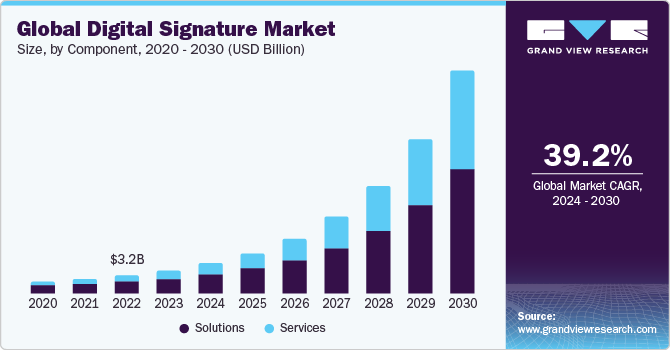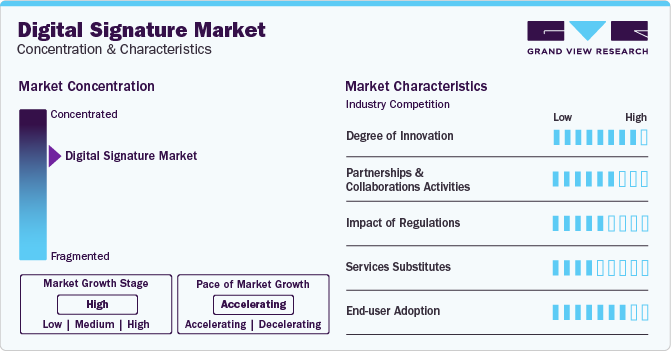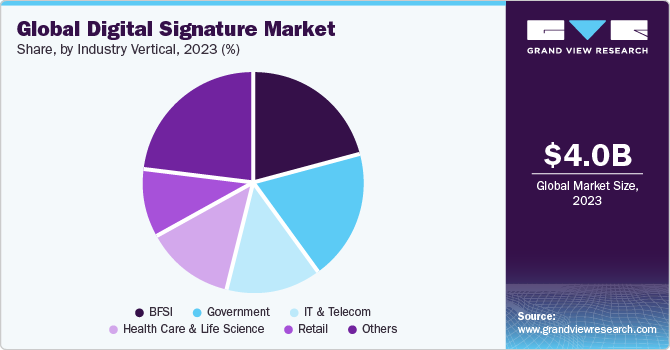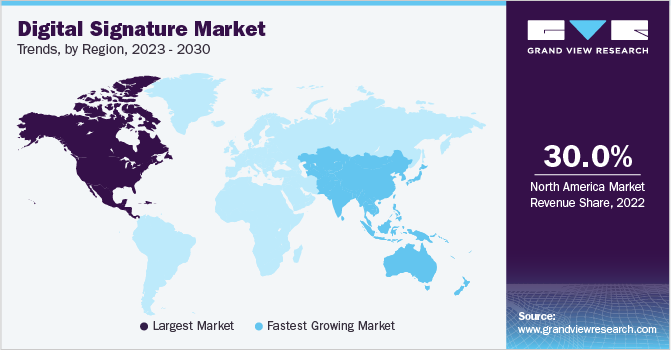- Home
- »
- Next Generation Technologies
- »
-
Digital Signature Market Size, Share & Growth Report, 2030GVR Report cover
![Digital Signature Market Size, Share & Trends Report]()
Digital Signature Market Size, Share & Trends Analysis Report By Component (Solutions, Services), By Level (AES, QES), By Deployment, By End-user, By Industry Vertical, By Region, And Segment Forecasts, 2024 - 2030
- Report ID: GVR-4-68040-074-9
- Number of Report Pages: 130
- Format: PDF, Horizon Databook
- Historical Range: 2017 - 2022
- Forecast Period: 2024 - 2030
- Industry: Technology
Digital Signature Market Size & Trends
The global digital signature market size was estimated at USD 4.03 billion in 2023 and is projected to grow at a CAGR of 39.2% from 2024 to 2030. A digital signature is an encrypted, electronic, stamp of authentication on digital information such as electronic documents, email messages, or macros. The growing investment among digital signature solution providing companies is major factor behind the increasing recognition of digital signatures in the business landscape. In addition, increasing adoption of smartphones and rising internet penetration is further driving the growth of the market.

The market growth is also attributed to the benefits provided by the solution, including faster tracking, remote signature, proof of origin, integrity and authentication validation, security and safety of electronic documents, and improved customer experience. For instance, instead of physically visiting the office, branch, or store, with digital signatures, customers can sign documents anywhere, anytime on any device. This technology makes it easier and faster to interact with businesses, which is specifically important for customers. This, in turn, turns into higher satisfaction and customer retention. Such benefits provided by digital signatures is expected to bode well for the growth of the market.
Numerous digital signature solution providers are focusing on launching new solutions to help customers with improved experience. For instance, in May 2023, APS Bank plc launched an innovative digital signatures solution, enabling customers to sign select documents remotely, without visiting a branch. The solution was introduced to help make the Bank’s customer experience simpler. Digital signatures provide a convenient and secure method for digitally signing documents, simultaneously contributing to the reduction of the carbon footprint of the bank. Besides being beneficial to the environmentthis solution also enhances efficiency by automating back-end processes such as document scanning and filing.
The growing adoption of advanced technologies such as Artificial Intelligence (AI), Machine Learning (ML), and Blockchain in digital signature solutions is further contributing to the growth of the market. Blockchain integration is gaining popularity, providing tamper-proof storage and verification for signed documents. AI and Machine Learning (ML) are being utilized for signature verification and advanced authentication. Thus, integrating emerging technologies such as blockchain, AI, and IoT unlocks new possibilities in the market.
Despite various benefits of digital signature solutions, there are some challenges that could hamper the growth of the market. The lack of awareness among individuals about the legality of digital signatures is a major challenge restraining the growth of the market. The varying legal regulation and recognition of digital signatures across various jurisdictions is the major factor responsible for a lack of awareness about the legality of digital signatures. In addition, the heavy dependency on technology and technical complexity also hinders the large-scale adoption of e-signatures.
Market Concentration & Characteristics
The digital signature industry can be characterized by a high degree of innovation with rapidly evolving technological advances. Increasing adoption of advanced authentication methods such as biometric authentication in digital signature solutions to ensure the validity and security of signatures is attributed to the growth of the industry.

The digital signature industry is also characterized by a high level of partnerships and collaboration activities by the companies. Companies are adopting these strategies to expand their offerings and increase their customer base. This has helped businesses to develop efficient solutions and expand their sales across different geographies.
Governments around the world are enacting electronic signature laws to provide legal recognition and enforceability to digitally signed documents. Regulatory trends in the digital signature industry involve compliance with region-specific standards and frameworks. For example, the European Union's eIDAS Regulation sets standards for electronic signatures, establishing a common framework for their use across EU member states.
There are no direct substitutes for digital signature solutions in the industry owing to their unique advantages and functionality. In addition, the legal, acceptance and recognition of digital signatures in many jurisdictions solidify their position as a reliable and trusted method of signing and authenticating documents.
End-use concentration is high in the digital signature industry. End-users in the digital signature industry include individuals, businesses, and organizations. These end users utilize digital signature solutions to verify and authenticate the integrity of their digital documents, transactions, and communications.
Component Insights
The solutions segment dominated the market with the largest revenue share of 65.0% in 2023. The segment includes software and hardware required for signing documents digitally. The growth of the solutions segment can be attributed to the convenience offered by this solution to users. It enables users to sign documents remotely and digitally safely and securely. For instance, in January 2022, Entrust Corporation announced the successful completion of the common criteria evaluation for its remote Qualified Signature Creation Device (QSCD). This enables the company to develop a solution that complies with eIDAS regulations, bringing together the entrust Signature Activation Module (SAM) and nShield Hardware Security Modules (HSMs).
The services segment is expected to register the fastest CAGR of 43.1% from 2024 to 2030. The growth of this segment can be attributed to increasing safety and security concerns while signing a document. Furthermore, rising cloud adoption for digital signature services also bodes well for the segment's growth. Additionally, Digital Signature Services (DSS) enable businesses, organizations, and individuals to access services focusing on consulting, implementation, and training. For instance, nowina.lu provides DSS that helps businesses transition from paper-based processes to digital workflows and enhance digital experience by prioritizing interoperability, which can drive growth and give businesses a competitive advantage.
Level Insights
The Advanced Electronic Signatures (AES) segment accounted for the largest market share in 2023. The dominance of the AES segment is primarily due to the adoption of AES for signatures for sensitive documents and high-value transactions. AES signatures are created by leveraging cryptographic algorithms that protect signatures from forgery. Furthermore, AES eliminates the need for physical documents and wet ink signatures, thereby reducing the costs of digital signatures.
The Qualified Electronic Signatures (QES) segment is expected to register the fastest CAGR from 2024 to 2030. QES segment's growth can be attributed to its high level of trust via face-to-face ID verification. QES requires an identity authentication before issuing a digital certificate, and customers are requested to electronically identify themselves during the signing process when prompted to verify their ID. Hence, as the most secure and assured signing method, demand for QES will grow from 2024 to 2030.
Deployment Insights
The on-premise segment accounted for the largest market share in 2023. Enterprises operating across industries, including healthcare, government, and medical, are sometimes subject to stringent state and federal laws governing the security and protection of their data and digital signature processes. For these companies, on-premise digital signature solutions are often required to ensure compliance with these regulations. This approach allows companies to have greater control over their data and signature flow while adhering to strict guidelines. As a result, on-premise digital signature solutions are the preferred choice for many enterprises, as they offer the best way to secure and manage their data and online signatures. Furthermore, companies such as airSlate Inc. and DigiSigner offer on-premise digital signature solutions to users, enabling them to ensure and maintain high data security.
The cloud segment is expected to register the fastest CAGR from 2024 to 2030. Increasing adoption of the cloud by several enterprises across the globe is expected to drive the segment's growth. For instance, in December 2022, according to Zippia, Inc., an internet publishing company, nearly 94% of enterprises across the U.S. used cloud services. Furthermore, companies such as Entrust Corporation are involved in offering a cloud-based turnkey solution that integrates with desktop and web applications supporting digital signatures. Hence, the aforementioned factors are expected to fuel the segment’s growth.
End-user Insights
The businesses segment accounted for the largest market share in 2023. Businesses segment growth can be attributed to the increasing adoption of digital signatures by businesses across the globe. Integration of digital signature solutions with existing workflow platforms and tools has simplified document management processes for businesses. Furthermore, benefits, such as improved customer experience by adding a digital signature, are expected to fuel the segment’s growth.
The organizations segment is expected to register the fastest CAGR from 2024 to 2030. Organizations segment's growth can be attributed to non-profit organizations' increasing adoption of digital signatures. Furthermore, various key companies offer non-profit organizations digital signature solutions. For instance, companies such as Zoho Corporation Pvt. Ltd. and DocuSign, Inc. provide digital signature solutions specifically for non-profit organizations. Moreover, the increasing development of digital signature solutions for the non-profit sector is anticipated to drive the segment’s growth. For instance, in October 2022, Convene launched the Digital Signature Suite, equipped with robust functionalities to enhance signing workflows with speed and security. This offering is designed for the company’s board governance clients spanning the private, government, and non-profit sectors within the GCC region.
Industry Vertical Insights
The BFSI segment accounted for the largest market share in 2023. The BFSI segment's growth is propelled by the rising adoption of digital transformation and the imperative for secure and efficient authentication procedures. Digital signatures provide various benefits, such as reduced paperwork, enhanced security, and streamlined operations. In the BFSI sector, where security and compliance are paramount, digital signatures offer a reliable way to authenticate and authorize contracts, transactions, and other finance-related documents. Hence, growing digitalization across BFSI sectors is anticipated to propel the segment's growth.

The government segment is expected to register the fastest CAGR from 2024 to 2030. The COVID-19 pandemic compelled government organizations and agencies to embrace digital signatures for signing documents electronically. Additionally, governments in various jurisdictions have enacted revisions to digital signature laws, approving their usage. As a result, government agencies are now actively seeking to provide citizens with a highly digitized experience. E-signature technology empowers individuals, non-profits, and government entities to continue conducting essential business in a secure and contact-free manner through digital signatures.
Regional Insights
North America dominated the digital signature market and accounted for a 30.2% share of the global revenue in 2023. The presence of prominent digital signature solution providers, such as DocuSign, Inc., Adobe, and Entrust Corporation, across the region is anticipated to fuel the regional market’s growth. Furthermore, a favorable legal environment for digital signatures across the North American region is anticipated to fuel its adoption in the upcoming years. In addition, a region is an early adopter of technology and suitable cloud infrastructure; the North American region is embracing the use of digital signatures.

U.S. Digital Signature Market Trends
The digital signature market in the U.S. is expected to grow at a significant CAGR of 37.6% from 2024 to 2030. Increasing adoption of e-business workflow and paperless documentation by businesses to save cost, streamline their processes, and boost productivity is driving the demand for digital signature solutions in the U.S.
Canada digital signature market is expected to grow at a significant CAGR from 2024 to 2030. Digital signatures are commonly utilized in Canada because they streamline the contractual process within a digital environment. The vast presence of laws and regulations governing the use of digital signatures in Canada is boosting the market’s growth.
Asia Pacific Digital Signature Market Trends
The digital signature market in Asia Pacific is anticipated to witness the fastest growth. Asia Pacific region's growth can be attributed to efforts put in by the government to enhance citizens' access to digital experiences. Countries, including India and China, are adopting digital technologies, leading to growth in the adoption of digital signatures across regions. Furthermore, a favorable legal environment across the region is anticipated to fuel regional growth from 2024 to 2030.
China digital signature market is expected to grow at a significant CAGR of 42.6% from 2024 to 2030. China's commitment to accelerating digitalization has led to the widespread adoption of digital signatures across diverse industries, which in turn, driving the growth of the market in the country.
The digital signature market in India is expected to grow at a significant CAGR from 2024 to 2030. Increasing government initiatives to promote the use of digital signatures across various sectors, including financial services, e-governance, and legal documentation, is driving the market’s growth in India.
Japan digital signature market is expected to grow at a significant CAGR from 2024 to 2030. Digital signature tools are expected to gain substantial traction in the country due to their capacity to mitigate concerns about fraud, identity theft, and data breaches.
Europe Digital Signature Market Trends
The digital signature market in Europe is expected to grow at a significant CAGR from 2024 to 2030. The strong regulatory framework and the rapid adoption of digital solutions across various industries are major factors behind the growth of the market.
The UK digital signature market is expected to grow at a significant CAGR from 2024 to 2030. The growth of the digital signature market in the country is primarily driven by increasing government initiatives related to digital signatures.
The digital signature market in Germany is expected to grow at a significant CAGR from 2024 to 2030. In Germany, the use of digital signature is steadily increasing. In the country, electronic signatures are legally acknowledged and governed by the eIDAS Regulation No. 910/2014 and the Trust Services Act (Vertrauensdienstegesetz - VDG).
Middle East & Africa Digital Signature Market Trends
The digital signature market in MEA is expected to grow at a significant CAGR from 2024 to 2030. Increasing smartphone penetration and usage and demand for mobile-friendly digital signature solutions that allow users to sign documents conveniently using their tablets or smartphones is boosting the growth of the market.
The Kingdom of Saudi Arabia (KSA) digital signature market is expected to grow at a significant CAGR from 2024 to 2030. The increasing adoption of digital technologies in various industries under the KSA government's Vision 2030 initiative, which aims to diversify the country's economy and promote digital transformation, is expected to create lucrative opportunities for the growth of the market.
Key Digital Signature Company Insights
Some of the key companies operating in the market include Docusign, Inc., Visma, Adobe Inc., GlobalSign, and Entrust Corporation.
-
Docusign, Inc. is a global leader in digital signature technology. The company provides an electronic signature solution that facilitates the electronic signing of agreements on various devices, ensuring a secure process that can be done virtually from any location worldwide.
-
Visma develops and provides software to small, medium, and large enterprises and the public sector to improve the work-life of millions of people around the globe. The company provides several digital tools that empower businesses and organizations to effectively organize, analyze, and enhance their day-to-day operations.
OneSpan Inc., IdenTrust, Inc., PrimeKey AB, Ascertia, and Topaz Systems, Inc. are some of the emerging companies in the digital signature market.
-
OneSpan Inc. specializes in anti-fraud and digital identity solutions that offer secure and improved experiences. The company offers digital agreement products and services that secure and automate revenue-generating and customer-facing business processes.
-
Topaz Systems, Inc. offers electronic signature solutions for digital documents, including bundled software tools, robust hardware pads, developer and technical support, and consultative product assistance.
Key Digital Signature Companies:
The following are the leading companies in the digital signature market. These companies collectively hold the largest market share and dictate industry trends.
- Docusign, Inc.
- SIGNiX, Inc.
- Adobe Inc.
- OneSpan Inc.
- GlobalSign
- IdenTrust, Inc.
- PrimeKey AB
- Visma
- Ascertia
- Topaz Systems, Inc.
- Entrust Corporation
Recent Developments
-
In December 2023, SIGNiX, Inc., and TruStage announced their collaboration to enhance and modernize the signing experience for members and customers across the U.S. through advanced digital signature capabilities.
-
In February 2023, GlobalSign introduced a cloud-based signing service, named Qualified Signing Service (QSS). This service is used for qualified electronic signatures and seals. Furthermore, this service complies with eIDAS, an EU regulation for electronic identification and trust services.
-
In February 2022, OneSpan Inc. and Smart Communications, a prominent technology company, announced a partnership that involved the integration of OneSpan Inc.’s OneSpan Sign, an e-signature product, into the Smart Communications platform to enhance the complete customer experience. This integration also enhanced operational efficiencies.
Digital Signature Market Report Scope
Report Attribute
Details
Market size value in 2024
USD 5.24 billion
Revenue forecast in 2030
USD 38.16 billion
Growth rate
CAGR of 39.2% from 2024 to 2030
Base year of estimation
2023
Historical data
2017 - 2022
Forecast period
2024 - 2030
Quantitative units
Revenue in USD million/billion, and CAGR from 2024 to 2030
Report coverage
Revenue forecast, company market share, competitive landscape, growth factors, and trends
Segments covered
Component, level, deployment, end-user, industry vertical, region
Regional scope
North America; Europe; Asia Pacific; Latin America; Middle East & Africa
Country scope
U.S.; Canada; Mexico; UK; Germany; Spain; France; Italy; China; India; Japan; Australia; South Korea; Brazil; UAE; The Kingdom of Saudi Arabia (KSA); South Africa
Key companies profiled
Docusign, Inc., SIGNiX, Inc., Adobe Inc., OneSpan Inc., GlobalSign, IdenTrust, Inc., PrimeKey AB, Visma, Ascertia, Topaz Systems, Inc., Entrust Corporation.
Customization scope
Free report customization (equivalent to up to 8 analysts working days) with purchase. Addition or alteration to country, regional, and segment scope
Pricing and purchase options
Avail customized purchase options to meet your exact research needs. Explore purchase options
Global Digital Signature Market Report Segmentation
The report forecasts revenue growth at global, regional, and country levels and provides an analysis of the latest industry trends in each of the sub-segments from 2017 to 2030. For this study, Grand View Research has segmented the global digital signature market report based on component, level, deployment, end-user, industry vertical, and region.
-
Component Outlook (Revenue, USD Million, 2017 - 2030)
-
Solutions
-
Services
-
-
Level Outlook (Revenue, USD Million, 2017 - 2030)
-
Advanced Electronic Signatures (AES)
-
Qualified Electronic Signatures (QES)
-
-
Deployment Outlook (Revenue, USD Million, 2017 - 2030)
-
Cloud
-
On-premise
-
-
End-user Outlook (Revenue, USD Million, 2017 - 2030)
-
Individuals
-
Businesses
-
Organizations
-
-
Industry Vertical Outlook (Revenue, USD Million, 2017 - 2030)
-
BFSI
-
Health Care & Life Science
-
IT & Telecom
-
Government
-
Retail
-
Others
-
-
Regional Outlook (Revenue, USD Million, 2017 - 2030)
-
North America
-
U.S.
-
Canada
-
Mexico
-
-
Europe
-
UK
-
Germany
-
Spain
-
France
-
Italy
-
-
Asia Pacific
-
China
-
Japan
-
India
-
South Korea
-
Australia
-
-
Latin America
-
Brazil
-
-
Middle East & Africa
-
UAE
-
The Kingdom of Saudi Arabia (KSA)
-
South Africa
-
-
Frequently Asked Questions About This Report
b. The global digital signature market size was estimated at USD 4.03 billion in 2023 and is expected to reach USD 5.24 billion in 2024.
b. The global digital signature market is expected to grow at a compound annual growth rate of 39.2% from 2024 to 2030 to reach USD 38.16 billion by 2030.
b. North America dominated the digital signature market with a share of 30.2% in 2023. The presence of prominent digital signature solution providers, such as DocuSign, Inc., Adobe, and Entrust Corporation, across the region is anticipated to fuel the regional market’s growth.
b. Some key players operating in the digital signature market include DocuSign, Inc.; SIGNiX, Inc.; Adobe; OneSpan; GlobalSign; IdenTrust, Inc.; PrimeKey AB; Visma; Ascertia; Topaz Systems, Inc.; and Entrust Corporation.
b. Key factors that are driving the digital signature market growth include a rise in internet and smartphone penetration and growing investments in digital signature solution-providing companies.
Share this report with your colleague or friend.
![gvr icn]()
NEED A CUSTOM REPORT?
We can customize every report - free of charge - including purchasing stand-alone sections or country-level reports, as well as offer affordable discounts for start-ups & universities. Contact us now
![Certified Icon]()
We are GDPR and CCPA compliant! Your transaction & personal information is safe and secure. For more details, please read our privacy policy.
We are committed towards customer satisfaction, and quality service.
"The quality of research they have done for us has been excellent."





